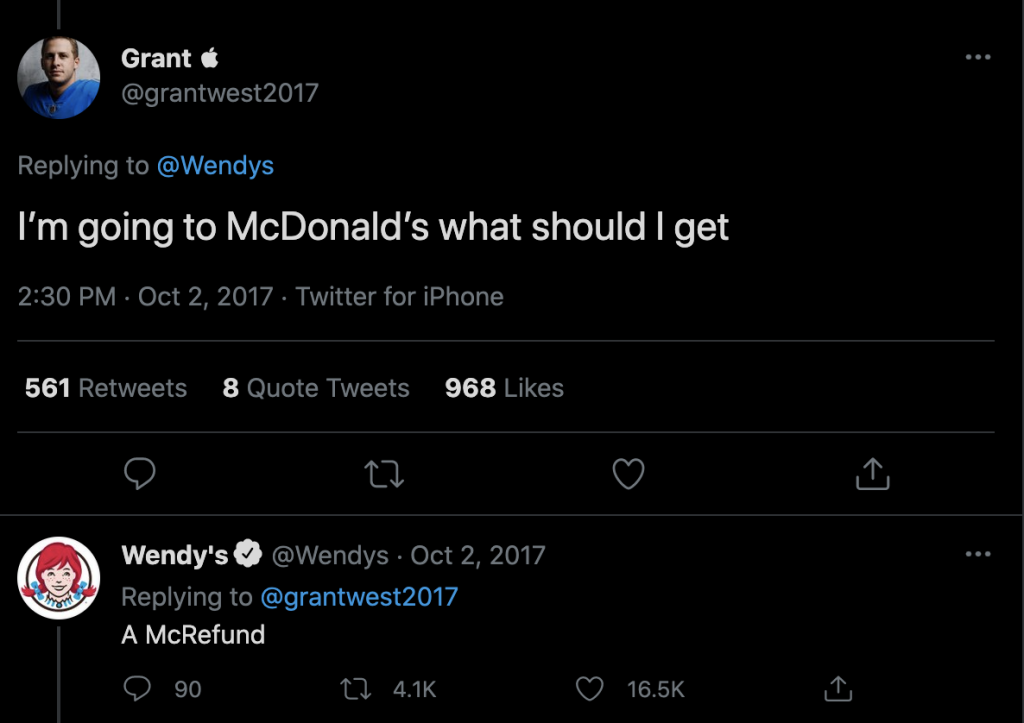Rosie Zbaracki, IG @visiblysold
There are lots of different ways to communicate online. How you use communication tools online, and the way you communicate with them, can affect your online persona. So how does a business create a positive persona online, and what style of communication is appropriate? How can your company learn to talk like a boss, drive sales, and provide great customer service all while driving sales?
According to a survey by Sprout Social, 3 out of 4 people prefer brands that use humor online (Sprout, 2017). Companies like Netflix have jumped wholeheartedly on the bandwagon, using funny GIFs and memes to drive interest for their most popular shows. Other brands known for humorous social media accounts include Taco Bell, Oreo, and the notorious shade throwing Wendy’s.

This might make you want to start bringing out the snarky dad jokes, but hold your horses. The same survey found that 88% of people were annoyed when brands mocked their customer base, and 71% of people were annoyed when brands engaged in politics (Sprout, 2017). 86% of people want brands online to be honest, 83% want them to be friendly, and 78% want helpfulness. Only 33% of people wanted brands to be snarky online (Sprout, 2017). Wendy’s strategy sure drove a lot of publicity, but the approach doesn’t have wide appeal. It is important to realize that not all publicity is good publicity. In fact, Wendy’s approach has most likely deterred people and lost them followers.
This segways into my final boss talk tips- how to deal with unhappy customers and trolls. The internet allows a feeling of anonymity, which can be especially felt when dealing with unhappy customers. A scathing review posted on your Facebook profile, a angry tweet at you, or a frustrated story on Instagram can be upsetting to deal with. It can also create a huge amount of backlash for your company if it goes viral.
You might remember #justiceforbradswife, a viral sensation in the spring of 2017. An angry spouse of a Cracker Barrel employee made a post on their Facebook account, and for some reason it went viral. The story got so big, it was featured in The Washington Post, got it’s own Facebook group, and a change.org petition with over 26,000 signatures. The original poster of the viral comment, Bradley Reid Byrd, actually implored his newfound fans to stop harassing his local Cracker Barrel. Cracker Barrel’s lack of response at the beginning of this saga didn’t help their case. When dealing with angry customers, it’s important to be polite but anticipate the viral mob mentality.
The major takeaways?
- 3 out of 4 people prefer brands with humor.
- Snarky, sarcastic, and rude content does not have wide appeal (unless you run one of those cafes that are rude to people on purpose).
- Whenever you post or interact with a potential customer, think about how that will reflect on the organization as a whole.
Sources:
The sprout social index: Edition xi: Social personality. (2021, January 27). Retrieved April 13, 2021, from https://sproutsocial.com/insights/data/q2-2017/
@grantwest2017 et. al, “I’m going to McDonald’s what should I get?” Twitter. 2 October, 2017.
Reid Byrd, Bradly (24 March, 2017). Post. Facebook.




I had never heard about the Cracker Barrel saga before! On one hand, it’s pretty funny. On the other, it’s an example of how social media + mob mentality can create problems for brands. I think Wendy’s shade-throwing is hilarious but definitely recognize that it’s a risky strategy that could alienate customers. Fast food companies do have the challenge of differentiating themselves from each other, especially when they’re incredibly similar like McDonalds and Burger King. I understand the choice that Wendy’s made to take a risk in order to stand out from the crowd.
This was a great post! I thought an interesting part of it was that 3 out of 4 people prefer brands that use humor online. I think we have all started to notice that trend with large corporations (Mcdonalds, Wendys, etc.) I also think the statistic 71% of people were annoyed when brands engaged in politics is interesting because in this past year it seems as if every company HAD to make a political statement or the public would view them in a bad light.
The statistics in this post were very interesting and surprising. Well done! There’s a difficult balance between trying to please customers, but also wanting to stand out at the same time. The Wendy’s example definitely stands out as a different approach, but doesn’t sound like it was necessarily effective in the long run.
Thank you for the insightful post. I think it’s interesting to look at the statistics behind this issue. There’s definitely a time and place for everything, and looking at those statistics puts that into perspective.